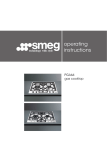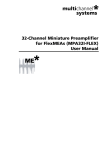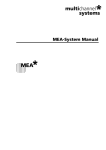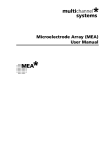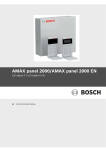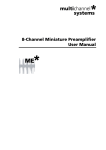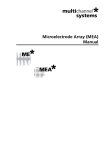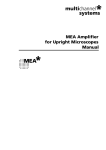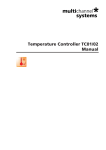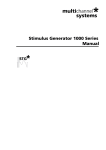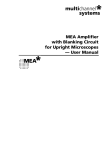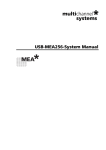Download USB-ME128-System Manual
Transcript
USB-ME128-System Manual Information in this document is subject to change without notice. No part of this document may be reproduced or transmitted without the express written permission of Multi Channel Systems MCS GmbH. While every precaution has been taken in the preparation of this document, the publisher and the author assume no responsibility for errors or omissions, or for damages resulting from the use of information contained in this document or from the use of programs and source code that may accompany it. In no event shall the publisher and the author be liable for any loss of profit or any other commercial damage caused or alleged to have been caused directly or indirectly by this document. © 2012 Multi Channel Systems MCS GmbH. All rights reserved. Printed: 23. 05. 2012 Multi Channel Systems MCS GmbH Aspenhaustraße 21 72770 Reutlingen Germany Fon +49-71 21-90 92 5 - 0 Fax +49-71 21-90 92 5 -11 [email protected] www.multichannelsystems.com Microsoft and Windows are registered trademarks of Microsoft Corporation. Products that are referred to in this document may be either trademarks and/or registered trademarks of their respective holders and should be noted as such. The publisher and the author make no claim to these trademark. Table of Contents 1 1.1 1.2 1.3 Important Safety Advice Important Safety Advice Guarantee and Liability Operator's Obligations 1 1 2 2 2 2.1 2.2 Introduction About this Manual Welcome to the USB-ME128-System 3 3 4 3 3.1 3.2 USB-ME128-System Setting Up and Connecting USB-ME128-System Front Panel 3.2.1 Power LED 3.2.2 Analog Inputs A and B 3.2.3 Digital Trigger Inputs Rear Panel 3.3.1 Digital In / Out 3.3.2 Digital Output D0 3.3.3 Synchronization Out- and Input 3.3.4 Audio Output 3.3.5 Analog Input 1 to 4 3.3.6 USB 3.3.7 Power Input 3.3.8 Ground 3.3.9 External Power Supply Connecting the USB-ME128-System 3.4.1 Connecting the USB-ME12864-System to a STG Software Installation 3.5.1 System requirements 3.5.2 Recommended BIOS settings 3.5.3 First Use of MC_Rack 3.3 3.4 3.5 5 5 5 5 5 5 6 6 6 6 7 7 7 7 7 7 9 9 10 10 10 11 4 4.1 4.2 4.3 4.4 4.5 Troubleshooting 13 About Troubleshooting 13 Technical Support 13 No Computer Connection / No Recording Possible 14 Cable Connection not correct / No Recording Possible 15 Triggering / Digital Input does not Work 15 5 5.1 5.2 5.3 5.4 5.5 Appendix Technical Specifications Pin Layout Contact Information Ordering Information Scope of Delivery 17 17 19 21 22 27 6 Index 29 iii 1 Important Safety Advice 1.1 Important Safety Advice Warning: Make sure to read the following advice prior to installation or use of the device and the software. If you do not fulfill all requirements stated below, this may lead to malfunctions or breakage of connected hardware, or even fatal injuries. Warning: Always obey the rules of local regulations and laws. Only qualified personnel should be allowed to perform laboratory work. Work according to good laboratory practice to obtain best results and to minimize risks. The product has been built to the state of the art and in accordance with recognized safety engineering rules. The device may only be used for its intended purpose; be used when in a perfect condition. Improper use could lead to serious, even fatal injuries to the user or third parties and damage to the device itself or other material damage. Warning: The device and the software are not intended for medical uses and must not be used on humans. Malfunctions which could impair safety should be rectified immediately. High Voltage Electrical cords must be properly laid and installed. The length and quality of the cords must be in accordance with local provisions. Only qualified technicians may work on the electrical system. It is essential that the accident prevention regulations and those of the employers' liability associations are observed. Each time before starting up, make sure that the power supply agrees with the specifications of the product. Check the power cord for damage each time the site is changed. Damaged power cords should be replaced immediately and may never be reused. Check the leads for damage. Damaged leads should be replaced immediately and may never be reused. Do not try to insert anything sharp or metallic into the vents or the case. Liquids may cause short circuits or other damage. Always keep the device and the power cords dry. Do not handle it with wet hands. Requirements for the installation Make sure that the device is not exposed to direct sunlight. Do not place anything on top of the device, and do not place it on top of another heat producing device, so that the air can circulate freely. 1 USB-ME128-System Manual 1.2 Guarantee and Liability The General conditions of sale and delivery of Multi Channel Systems MCS GmbH always apply. The operator will receive these no later than on conclusion of the contract. Multi Channel Systems MCS GmbH makes no guarantee as to the accuracy of any and all tests and data generated by the use of the device or the software. It is up to the user to use good laboratory practice to establish the validity of his / her findings. Guarantee and liability claims in the event of injury or material damage are excluded when they are the result of one of the following. Improper use of the device Improper installation, commissioning, operation or maintenance of the device Operating the device when the safety and protective devices are defective and/or inoperable Non-observance of the instructions in the manual with regard to transport, storage, installation, commissioning, operation or maintenance of the device Unauthorized structural alterations to the device Unauthorized modifications to the system settings Inadequate monitoring of device components subject to wear Improperly executed and unauthorized repairs Unauthorized opening of the device or its components Catastrophic events due to the effect of foreign bodies or acts of God 1.3 Operator's Obligations The operator is obliged to allow only persons to work on the device, who are familiar with the safety at work and accident prevention regulations and have been instructed how to use the device; are professionally qualified or have specialist knowledge and training and have received instruction in the use of the device; have read and understood the chapter on safety and the warning instructions in this manual and confirmed this with their signature. It must be monitored at regular intervals that the operating personnel are working safely. Personnel still undergoing training may only work on the device under the supervision of an experienced person. 2 2 Introduction 2.1 About this Manual It is assumed that you already have a basic understanding of technical and software terms. No special skills are required to read this manual. If you are using the device for the first time, please read the Important Safety Advice before installing the hardware and software, where you will find important information about the installation and first steps. The device and the software are part of an ongoing developmental process. Please understand that the provided documentation is not always up to date. The latest information can be found in the Help. Check also the MCS web site (www.multichannelsystems.com) for downloading up-to-date manuals and help files. 3 USB-ME128-System Manual 2.2 Welcome to the USB-ME128-System The USB-ME128-System is a stand-alone solution for acquiring data from up to 128 channels. It can replace the internal computer hardware MC_Card. The analog input signals are acquired and digitized by the USB-ME128-System and the digital electrode signals are transmitted to the connected computer via universal serial bus (High Speed USB 2.0). Thus, it is possible to use any computer for data processing. Recorded data are graphed, analyzed, and reviewed with the powerful and easy-to-use MC_Rack program. You can export the data in standard formats to other programs with the software MC_DataTool. The USB-ME128-System supports 128 channels with an amplification factor 1 that means no amplification, data acquisition only. It is a high flexible system: You can connect, for example, two MEA60-Systems via MCS high grade cables, or one MEA120-Systems or ME-Systems in different configurations or whatever comes with 68-pin MCS standard connectors. Please see "Microelectrode Array Systems" and "Microelectrode Array USB-Systems" for more information. You can stack several USB-ME128Systems but you need a separate data proceeding computer with MC_Rack for each system. 4 3 USB-ME128-System 3.1 Setting Up and Connecting USB-ME128-System USB-ME128-System is a high flexible system. Via MCS high grade cables it is possible to connect, for example, a MEA60-System or two MEA120-Systems or ME-Systems with at least 128 channels to the 128 analog inputs. Example: The description of the installation includes an example setup with a MEA1060 amplifier two MEA1060 amplifiers without blanking circuit. Warning: Please read the separate manuals of all devices before installation, especially the warnings and safety information. Make sure all devices are switched off before you connect them to the power supply. Damage to the devices and even fatal injuries may result from improper installation or use. Note: Using a USB hub for connecting the USB-ME128-System to the computer is not recommended. The system needs a broad bandwidth for the data transmission. Recording might not be possible, especially if a second device that sends or receives continuous data streams, for example a web cam or USB speakers, is connected to the same USB port. 3.2 Front Panel 3.2.1 Power LED The Power LED lights up when the USB-ME128 is connected via power supply unit to the power supply system. 3.2.2 Analog Inputs A and B The 68-pin MCS standard connectors on the front panel of the device is an analog input are analog inputs for the data streams coming from the connected amplifiers. The connector on the front panel labeled with A and B communicates communicate with the digital Trigger Inputs 0 and 1. The MCS high grade cables (C68x1M or C68x3M) with 68-pin MCS standard connectors on both heads are used to connect MEA or ME amplifiers to the USB-ME128 for analog data transfer. Please read chapter "Pin Layout" (68-pin MCS standard connector) in the Appendix. 3.2.3 Digital Trigger Inputs The Digital Trigger Inputs needs need Lemo coaxial cables with BNC connectors for the MEA amplifier at one head and Lemo connectors at the other head for the USB-ME128 device (C-BNC-Lemo). The Digital Trigger Inputs accept TTL pulses from any device, for example, signals from a stimulus generator STG for triggering the system, and they control the recording. 5 USB-ME128-System Manual 3.3 Rear Panel 3.3.1 Digital In / Out A Digital IN / OUT for 16 digital in- and output bits is available (68-pin MCS standard connector). The Digital IN / OUT connection accepts or generates standard TTL signals. TTL stands for Transistor-Transistor Logic. A TTL pulse is defined as a digital signal for communication between two devices. A voltage between 0 V and 0.8 V is considered as a logical state of 0 (LOW), and a voltage between 2 V and 5 V means 1 (HIGH). The Digital OUT allows generating a digital signal with up to 16 bits and read it out for example by using a Signal Divider SD16 from MCS. You can utilize this digital signal to control and synchronize other devices with the USB-ME128. Bit 0 of the Digital OUT is separated and available as Lemo connector DIG OUT D0. So if you need only one bit of the digital signal, you don’t need the additional signal divider SD16. Please read chapter "Pin Layout" (Digital IN / OUT Connector) in the Appendix for more information. The Digital IN can be used to record additional information from external devices as a 16-bit encoded number. The Digital IN is most often used to trigger recordings with a TTL signal from a stimulator. Therefore, the bits 0, 1, 2 and 3 of the Digital IN are accessible as the Lemo connectors on the front panel. The 16 digital input channels are represented as the digital data stream, that is, a stream of 16-bit values, each bit (0 to 15) representing one digital input. Standard TTL signals are accepted as input signals on the digital inputs. Unused input bits, which have an undefined state, should be masked in the Trigger Detector of MC_Rack. Warning: A voltage that is higher than +5 Volts or lower than 0 Volts, that is, a negative voltage, applied to the digital input would destroy the electronics. Make sure that you apply only TTL pulses (0 to 5 V) to the digital inputs. 3.3.2 Digital Output D0 The Bit 0 of the Digital OUT is also accessible independently from the 68-pin Digital IN / OUT connector. The digital output channel D0 is generally used for synchronizing the USB-ME128System with a stimulus generator, or with another data acquisition system, for example, an imaging or a patch clamp system. The DIG OUT D0 generates standard TTL pulses. 3.3.3 Synchronization Out- and Input If you want to use several USB-ME128-Systems in parallel, the SYNC OUT and SYNC IN can be used to synchronize the individual devices. The SYNC OUT of the first device must be connected to the SYNC IN of the second, and so on. For the connection you need cable with Lemo plugs on both heads (C-Lemo-Lemo). Warning: Do not use the SYNC IN and SYNC OUT to connect the USB-ME128 to any other device than another USB-ME128. 6 USB-ME128-System 3.3.4 Audio Output To the AUDIO OUT (3.5 mm phone jack) you can connect an audio system to make the electrical activity audible. By software control, it is possible to convert signals from one data channel into sound. A computer with a sound card and speakers or a headset is required. You can use this feature to hear Electrode Raw Data, for example, or to replay recorded sound. Or you can use an analog channel as a sound input and record any sounds. Thus you can add spoken commentary to document your data. Only Analog Raw Data, Electrode Raw Data, and Filtered Data can be converted into sound. The quality of the sound is mono. Note: You can add only one sound instrument to your rack, and you can convert only one channel into sound. 3.3.5 Analog Input 1 to 4 Four additional analog inputs are available, separated from 68-pin MCS standard connector B on the front panel, Pin Number 125, 126, 127 and 128. See Appendix chapter ”Pin Layout” (68-pin MCS standard connector). The MEA1060 amplifier delivers analog data streams from 60 channels to the input connector on the front side of the USB-ME128. Pin Number 1, 67 and 68 are used for the external power supply, Pin Number 2 is for grounding the signal, GNDS. There are four free channels left, Pin No. 63, 64, 65 and 66, that is for Analog IN 1 to 4. The additional analog inputs 1 to 4 are intended for recording additional information from external devices, for example, for recording patch clamp in parallel to the MEA recording, for monitoring the temperature, or for recording voice. You could also use the analog inputs for triggering, but please note that the digital inputs, especially DIG OUT D0, are intended for accepting TTL pulses. As the gain is generally completely different on the electrode inputs and on the additional analog inputs, signals on the analog channels are recorded "as is", with no respect to the gain specified in MC_Rack. 3.3.6 USB The USB connector is used to transfer the digitized data from all data channels and the additional digital and analog channels to any connected data acquisition computer via USB High Speed 2.0 (type A - mini B) cable. 3.3.7 Power Input Connect here the power supply unit. This power supply powers the USB-ME128 main unit only. The device needs 12 V and .. 3.3.8 Ground If an additional ground connection is needed, you can connect this plug with an external ground using a standard common jack (4 mm). 3.3.9 External Power Supply External Power Supply: Plug in for the external power supply, for example, PS40W. The external power supply energizes the devices that are connected to the USB-ME128, for example, filter amplifier, gain amplifier or MEA amplifier with blanking circuit. The conductive path from the three pins of the plug in runs through the device to the front 68-pin MCS standard connector and occupies Pin Number 1, 67 and 68. (Please see also chapter "Pin layout" 68-pin MCS standard connector in the Appendix). 7 USB-ME128-System Manual The PS40W is a standard power supply delivering supply voltages to connected devices. The PS40W is especially recommended for use with Multi Channel Systems products, for example it is perfect for supplying power to MEA1060BC or to programmable gain amplifiers PGA and for other custom setups that lack an internal power supply IPS10W. It supplies power with +/- 7 V output voltage, 2.5 A output current, and about 40 W output power. The PS40W stabilizes two voltages using the linear regulation technique. The outputs of the device have over-current and over-temperature protection. In case of a failure of the PS40W, the output voltages are decreased. Fuses protect the electronic components against fatal damages. Important: Do not mismatch the polarity of the power supply. A false connection may cause permanent damages. Note: If by any cause the supply voltages are reduced, the recorded signals could be deformed. Please do not place the external power supply device PS40W near to the data acquisition device in experimental setup! The PS40W will disturb the data acquisition with 50 Hz hum, that is why the PS40W should be placed in a distance to the data acquisition device. Cabling For Digital Out D0, and Analog Input 1 to 4 on the rear panel of the device you need the same special coaxial cable as for the Digital Trigger In plugs on the front panel: Lemo cable with one head BNC connector, the other head "Lemo" connector. Please see picture above. Sync In and Sync Out need Lemo cable with two Lemo connectors. 8 USB-ME128-System 3.4 Connecting the USB-ME128-System 1. Provide a power supply in the immediate vicinity of the installation site. 2. Place all devices on a stable and dry surface, where the air can circulate freely and the devices are not exposed to direct sunlight. 3. Set up the computer (with installed MC_Rack program). 4. Set up the MEA1060 amplifiers as described in the MEA1060 Manual. 5. Connect the MEA amplifiers with MCS High Grade cables (C68x1M) to the 68-pin MCS standard connectors A and B on the front panel of the USB-ME128. 6. Connect the USB output connector to a free USB 2.0 port of the data acquisition computer. It is not recommended to use an USB hub. 7. Connect the USB-ME128 via power supply unit to a power outlet of the same electrical system (connected to the same ground / earth wire) as all other components of the setup, for example, the computer or shielding. 8. Ground the system. 9. Check the power LED on the front panel. It should light up as soon as the power line is connected. If not, check the power source and cabling. 10. (Install the MC_Rack program from the installation volume if it is not already installed.) 11. Start the MC_Rack program and select the USB-ME128-System as the data source. Please see the MC_Rack help / manual for more details on how to define the data source. 3.4.1 Connecting the USB-ME128-System to a STG Connect the MEA amplifiers with two MCS high grade cables (C68x1M) to the 68-pin MCS standard connectors A and B on the front panel of the USB-ME128. Connect a Sync Out of a stimulus generator STG via T- connector at one hand to the BNC connector of the MEA amplifiers, and at the other hand to the Digital Trigger IN 0 to 1 at the front panel of the USB-ME128 device. Make sure that 68-pin MCS standard connector A of MEA amplifier A communicates with Digital Trigger IN 0, MEA amplifier B with 1. Please see the following suggestion. 9 USB-ME128-System Manual 3.5 Software Installation Please check the system requirements before you install the MC_Rack software. MCS cannot guarantee that the software works properly if these requirements are not fulfilled. Please see the MC_Rack help or manual for more information. It is recommended that you check the MCS web site for software updates on a regular basis. The USB-ME128-System is a plug and play device. The driver is automatically installed together with the MC_Rack program. It is easier to connect the USB-ME128-System first to the data acquisition computer and then install MC_Rack. Important: Please make sure that you have full control over your computer as an administrator. Otherwise, it is possible that the installed hardware does not work properly. 3.5.1 System requirements One of the following Microsoft Windows ® operating systems is required: Microsoft Windows 7, VISTA or XP (English and German versions supported) with the NT file system. Other language versions may lead to software errors. Hardware: (Not required for offline analysis or demo mode) The data acquisition board USBME128-System. If no USB-ME128-System is present, MC_Rack opens in a simulation mode. A computer with low performance may lead to performance limits more often; therefore, MCS recommends an up-to-date computer optionally with a separate hard disk. Please note that there are sometimes hardware incompatibilities of the USB-ME128-System and computer components; or that an inappropriate computer power supply may lead to artifact signals. Please contact your local retailer for more information on recommended computer hardware. Important: You need to have installed the latest USB-ME128-System driver to operate the USBME128-System, which is automatically installed with MC_Rack. The installation may be invalid if the USB-ME128-System does not respond. Please contact Multi Channel Systems or your local retailer in this case. 3.5.2 Recommended BIOS settings Recommended operating system settings The following automatic services of the Windows operating system interfere with the data storage on the hard disk and can lead to severe performance limits in MC_Rack. These routines were designed for use on office computers, but are not very useful for a data acquisition computer. Turned off Screensaver. Turned off Windows Indexing Service for all local disks. Turned off Windows System Restore. Turned off Optimize hard disk when idle (automatic disk fragmentation). Manual management of automatic Windows Update. Power Options: Power scheme: Never turned off monitor, hard disk and system standby. It is also not recommended to run any applications in the background when using MC_Rack. Remove all applications from the Autostart folder. Be careful when using a Virus Scanner. These programs are known to disturb MC_Rack, and even data loss may occur. When using an USB-ME128-System it is recommended to connect a high performance computer with a separate hard disk for program files and data storage. The provided possibility to use up to 128 channels with up to 40 kHz needs high memory capacity. Please remove data and defragment the hard disk regularly to ensure optimal performance. 10 USB-ME128-System 3.5.3 First Use of MC_Rack It is also not recommended to run any applications in the background when using MC_Rack. Remove all applications from the Autostart folder. Warning: The operating system settings of the data acquisition computer were preconfigured by MCS and should not be changed by the user. Changing these settings can lead to program instabilities and data loss. Installing MC_Rack with the USB-ME128-System connected to the computer The Windows operating system detects a new hardware when the USB-ME128-System is connected to the computer, if the program has not been installed beforehand. Please make sure the device has power, that is, the power LED is lighting. Simply cancel the "Found New Hardware Wizard" and proceed with the installation of the MC_Rack program. Connecting the USB-ME128-System to a computer with installed MC_Rack If MC_Rack had already been installed on the computer before the hardware was connected, the operating system needs to load the driver once. After this procedure, the USB-ME128System will be automatically recognized by the operating system. 1. Connect the USB-ME128-System to the USB port of the data acquisition computer. Please make sure the device has power, that is, the power LED is lighting. 2. Switch the computer on. The "Found New Hardware Wizard" is displayed. 1. Choose the option "No", not this time and continue with "Next". 2. Choose the option "Install" the software automatically (Recommended) and continue with "Next". 3. The Wizard will automatically find the appropriate USB-ME128-System driver. Continue with "Next". 4. The driver installation is finished. Please check the system requirements before you install the MC_Rack software. MCS cannot guarantee that the software works properly if these requirements are not fulfilled. Please see the MC_Rack Help or Manual for more information. It is recommended that you check the MCS web site for software updates on a regular basis. 1. Double-click Setup.exe on the installation volume. The installation assistant will show up and guide you through the installation procedure. 1. Follow the instructions of the installation assistant. The USB-ME128-System driver and MC_Rack are installed (or updated) automatically. 11 4 Troubleshooting 4.1 About Troubleshooting The following hints are provided to solve special problems that have been reported by users. Most problems occur seldom and only under specific circumstances. Please check the mentioned possible causes carefully when you have any trouble with the product. In most cases, it is only a minor problem that can be easily avoided or solved. If the problem persists, please contact your local retailer. The highly qualified staff will be glad to help you. Please inform your local retailer as well, if other problems that are not mentioned in this documentation occur, even if you have solved the problem on your own. This helps other users, and it helps MCS to optimize the instrument and the documentation. Please pay attention to the safety and service information in the separate user manuals of the related products and in the software help. Multi Channel Systems has put all effort into making the product fully stable and reliable, but like all high-performance products, it has to be handled with care. 4.2 Technical Support Please read the chapter "Troubleshooting" of the user manual first. Most problems are caused by minor handling errors. Contact your local retailer immediately if the cause of trouble remains unclear. Please understand that information on your hardware and software configuration is necessary to analyze and finally solve the problem you encounter. Please keep information on the following at hand: Description of the error (the error message text or any other useful information) and of the context in which the error occurred. Try to remember all steps you had performed immediately before the error occurred. The more information on the actual situation you can provide, the easier it is to track the problem. The serial number of the device. You will find it on the backside of the housing or click "About" in "Help" in the main menu of MC_Rack. The amplifier type and serial numbers of the connected amplifiers. You will find them on the devices. The operating system and service pack number of the connected computer. The hardware configuration (microprocessor, frequency, main memory, hard disk) of the connected computer. This information is especially important if you have modified the computer or installed new hard- or software recently. The version of the recording software. On the "Help menu", click "About" to display the software version. 13 USB-ME128-System Manual 4.3 No Computer Connection / No Recording Possible You cannot establish a connection to the computer. The USB-ME128-System channel layout is not available in MC_Rack. When loading a previously saved virtual rack file, you will get an error message and the simulator will be started automatically. Or you get an error message when starting the recording in MC_Rack after a successful computer connection. Possible causes: ? The power LED is not lightning. The supply power is not connected or there is a technical problem with the instrument. Check the power source and the cable connections. If this does not solve the problem, contact your local retailer for support. ? The power LED is lighting. The USB port might not support USB 2.0 or might not be working. Check the USB port. Only full speed USB 2.0 ports can be used. Try another USB 2.0 port. ? You can establish a connection, but get an error message when starting the recording in MC_Rack. The bandwidth of the USB port is not sufficient for recording. This can be the case if the USB-ME128-System is connected via USB hub, and a second device that sends or receives continuous data streams, for example, a web cam or USB speakers, is connected to the same USB port. Connect the USB-ME128-System directly to a USB port, not via hub. 14 Troubleshooting 4.4 Cable Connection not correct / No Recording Possible You cannot establish a signal from the amplifier. The USB-ME128-System channel layout in MC_Rack shows 50 Hz hum only. Possible causes: ? The cable connection from the computer to the periphery is not complete. 68-pin MCS standard connectors need to be fixed in the provided plugs by a firm connection. Otherwise no data transfer is possible. Check the MCS high grade cable, and the 68-pin MCS standard connectors. If this does not solve the problem, contact your local retailer for support. ? The cable connection from the computer to the periphery is not correct. Make sure not to mistake inputs for outputs in the connected devices. 4.5 Triggering / Digital Input does not Work You have connected a TTL source (for example, the Sync Out of a stimulus generator) to the digital output D0 of the USB-ME128-System, and configured the virtual rack in MC_Rack for triggering displays or data acquisition by the TTL source, but you do not see any sweeps. Possible causes: ? The TTL source does not generate true TTL signals (5 V TTL level), or the TTL pulse duration is too short in combination with the sampling rate, so that the pulse is missed in-between two data points. The USB-ME128-System can only accept TTL signals (5 V TTL level) as a digital input stream. The TTL pulse needs to be optimized according to the sampling rate. Otherwise, a detection of the trigger cannot be guaranteed. ? The software settings for the Trigger Detector do not match with the hardware configuration. In MC_Rack, add a Trigger Detector to your virtual rack, and select the Digital Data D1 input stream as the Trigger. Check the pin layout of the digital IN / OUT connector and make sure that the same bit input that is connected is selected in the software. (The standard settings of the Trigger Detector are for using bit 0.) Mask all unused bits. Select the appropriate logical state (generally HIGH) for triggering. Please see the MC_Rack help or manual for more details. 15 5 Appendix 5.1 Technical Specifications The USB-ME128-System is an analog / digital board converting analog signals in digital data streams in real time. Warning: The device may only be used together with MEA-Systems or ME-Systems from Multi Channel Systems MCS GmbH, and only for the specified purpose. Damage of the device and even fatal injuries can result from improper use. Do not open the data acquisition box and do not change hardware configuration as it could lead to improper behavior of the system. General characteristics Operating temperature 10 °C to 50 °C Storage temperature 0 °C to 50 °C Relative humidity 10 % to 85 %, non-condensing Dimensions (L x D x H) 210 x 210 x 50 mm Weight 1850 g Signal inputs Number of analog recording channels 128 Input voltage +/- 4 V Input impedance 10 k Bandwidth DC to 13 kHz Number of additional analog inputs 4 Input voltage range +/- 4.096 V Bandwidth DC to 15 kHz Input impedance 1 M || 1 nF DC offset max. +/- 2 mV Number of digital input channels 16 Digital input signals CMOS (3.3 V input) Number of digital output channels 16 Digital output signals TTL ( 3.3 V output) Sampling frequency up to 50 kHz (software controlled) Maximal data rate 20.5 MB/s Data resolution 16 Bit Data transfer USB 2.0 High Speed (true USB 2.0 transfer rate) 17 USB-ME128-System Manual Cross talk ( neighbour channel) typical 0.01 %, maximal 0.025 % Cross talk (other channels) incapable of measurement DC offset maximal +/- 2 mV Interface and connectors Front panel 42 Digital Inputs Lemo connector, EPL.00.250 NTN 42 x 64 Analog In 68-pin MCS standard connectors, MCS high grade cable Rear panel 1 16 Bit Digital In / Out 68-pin MCS standard connectors, MCS high grade cable 1 Digital Out D0 Lemo connector, EPL.00.250 NTN 1 Sync In Lemo connector, EPL.00.250 NTN 1 Sync Out Lemo connector, EPL.00.250 NTN 1 Audio Output Stereo jack 3.5 mm, FFA.00.250 CTAC29 4 Analog Inputs Lemo connector, EPL.00.250 NTN USB USB 2.0 High Speed cable (type A - mini B, 5 pin) Power Supply DC PWR 0.7 x 2.35 mm, PWR DC 0.65 x 2.75 mm Ground Common jack 4 mm, banana plug External Power through Lemo EPG.0B.303 HLN Power supply unit (MPU 30) Input voltage 90 – 264 VAC @ 47 – 63 Hz Output voltage 11 – 13 V Max. Power 30 W Software Operating system Microsoft Windows ® 7, XP or Vista with NTFS English and German version supported MC_Rack program Data acquisition and analysis software Version 3.6.3 and higher MC_DataTool program Data export software Version 2.4.1 and higher Axon binary file (*.abf), ASCII file (*.txt), binary file (*.raw) LTP-Director Data acquisition, stimulation and analysis software Version 1.2.0 18 Appendix 5.2 Pin Layout Analog IN Pin Layout 68-Pin MCS Standard Connector Analog In A B Pin 1: GNDP (power ground) GNDP (power ground) Pin 2: GNDS (signal ground) GNDS (signal ground) Pin 3 to 66 Channels 1 - 64 65 - 128 Pin 67 Pos. voltage supply Pos. voltage supply Pin 68 Neg. voltage supply Neg. voltage supply Galvanically isolated voltage supply and ground. Pin 1, 67, and 68 are connected to the external power supply, for example, PS40W. Additional ANALOG IN Please note that channels 125 to 128 are not used for recording analog data from MEA amplifier. The 68-pin MCS standard connector has 64 possible channels for recording, but MEA amplifier only has 60 channels for recording data. That is why pin No. 63 to 66 are diverged from 68-pin MCS standard connector B at the front panel and connected to the Analog 1 to 4 at the rear panel. These channels are used for the additional analog inputs of the USB-ME128. Analog 1 Channel 125 Connector B, Pin 63 Analog 2 Channel 126 Connector B, Pin 64 Analog 3 Channel 127 Connector B, Pin 65 Analog 4 Channel 128 Connector B, Pin 66 19 USB-ME128-System Manual Digital IN / OUT Connector 68-Pin MCS Standard Connector Digital Out D0 20 Bit 0 of the 16 bit digital output channels (Pin 3) Pin 1 GNDP (power ground) Pin 2 GNDS (signal ground) Pin 3 - 10 Digital output channels bit 0 - 7 Pin 11 - 14 GNDS (signal ground) Pin 15 - 22 Digital output channels bit 8 - 15 Pin 23 - 26 GNDS (signal ground) Pin 27 - 34 Digital input channels bit 0 - 7 Pin 35 - 38 GNDS (signal ground) Pin 39 - 46 Digital input channels bit 8 - 15 Pin 47 - 48 GNDS (signal ground) Pin 49 - 63 Internal use (do not connect) Pin 64 - 66 GNDS (signal ground) Pin 67 Positive supply voltage output Pin 68 Negative voltage supply output Appendix 5.3 Contact Information Local retailer Please see the list of official MCS distributors on the MCS web site. User forum The Multi Channel Systems User Forum provides the opportunity for you to exchange your experience or thoughts with other users worldwide. Mailing list If you have subscribed to the mailing list, you will be automatically informed about new software releases, upcoming events, and other news on the product line. You can subscribe to the list on the contact form of the MCS web site. www.multichannelsystems.com 21 USB-ME128-System Manual 5.4 Ordering Information Please contact your local retailer for pricing and ordering information. MEA-Systems Product Product Number Description MEA recording system for inverted microscopes, 60 electrode channels MEA60-InvSystem Complete with 5 MEAs, data acquisition computer with MC_Card and IPS10W, MEA1060-Inv amplifier, TC01, ALA MEAPPORT2, and accessories MEA recording system for upright microscopes, 60 electrode channels MEA60-UpSystem Complete with 5 MEAs, data acquisition computer with MC_Card and IPS10W, MEA1060-Up amplifier, TC01, ALA MEAPPORT2, and accessories MEA recording system for inverted microscopes with advanced perfusion,60 electrode channels MEA60-InvSystemE Complete with 5 MEAs, data acquisition computer with MC_Card and IPS10W, MEA1060-Inv amplifier, TC02, PH01, ALA MEA-PPORT2, and accessories MEA recording system for upright microscopes with advanced perfusion,60 electrode channels MEA60-UpSystemE Complete with 5 MEAs, data acquisition computer with MC_Card and IPS10W, MEA1060-Up amplifier, TC02, PH01, ALA MEA-PPORT2, and accessories MEA recording system for inverted microscopes, 120 electrode channels MEA120Inv-System Complete with 5 MEAs, data acquisition computer with MC_Card and IPS10W, 2 x MEA1060-Inv amplifier, TC02, ALA MEA-PPORT2, and accessories MEA recording system for upright microscopes, 120 electrode channels MEA120Up-System Complete with 5 MEAs, data acquisition computer with MC_Card and IPS10W, 2 x MEA1060-Up amplifier, TC02, ALA MEAPPORT2, and accessories USB-MEA recording system for inverted and upright microscopes, 256 electrode channels USBMEA256System Complete with 5 x 256MEAs, data acquisition, data conversion, and filter amplification, 252 recording channels, 4 additional analog channels, 1 digital I/O port, and USB 2.0 High Speed data transfer to any computer. 22 Appendix MEA Amplifiers Product Product Number Description MEA amplifier for inverted microscopes MEA1060Inv Probe interface and 60 channel pre- and filter amplifier with custom gain and bandwidth MEA amplifier for upright microscopes MEA1060Up MEA amplifier with blanking circuit for inverted microscopes MEA1060Inv-BC MEA amplifier with blanking circuit for upright microscopes MEA1060Up-BC Probe interface and 60 channel pre- and filter amplifier with custom gain and bandwidth. The blanking circuit prevents the amplifier from getting saturated and thus prevents stimulus artifacts. Accessories Product Product Number Description MEA culture chamber CCIR Suitable for all MEAs with plastic ring and thread. Simply screw the culture chamber onto the plastic holder on the MEA. An Oring ensures that the chamber fits tightly and is leakproof. Autoclavable. Complete with lid. MEA culture chamber lid CCL Additional or replacement lid for MEA culture chamber. Sealed MEA culture dish ALA MEAMEM MEA culture chamber with transparent semi-permeable membrane suitable for all MEAs with glass ring. Simply slide the culture chamber over the glass ring. A hydrophobic semipermeable foil from Dupont that is selectively permeable to gases (O2, CO2), but not to fluid, keeps your culture clean and sterile, preventing contaminations by airborne pathogens. It also greatly reduces evaporation and thus prevents a dry-out of the culture. Autoclavable. Comes complete with membranes. ALA MEASHEET Set of 10 membranes for sealed MEA culture dishes. ALA MEAMEM5 Set of 5 membranes and MEA-MEM-TOOL for sealed MEA culture dishes ALA MEAMEMTOOL Tool for smoothing and positioning the membrane on the ALA MEA-MEM culture chamber, so that the membrane is neat and flat on top of the culture chamber. MEA perfusion insert ALA MEAINSERT 23 USB-ME128-System Manual ME-Systems Product Product Number Description Data acquisition system with 16 analog channels ME16System Data acquisition system with 32 analog channels ME32System Complete with data acquisition computer with MC_Card and IPS10W, and software package Data acquisition system with 64 analog channels ME64System Data acquisition system with 128 analog channels ME128System ME recording system with 16 analog channels and filter amplifier with fixed gain USB-ME16FAI-System Stand-alone system for extracellular recordings, complete with 2 x MPA8I, integrated FA16I, integrated 16 channel data acquisition, USB 2.0 data transfer to any computer, and software package ME recording system with 32 analog channels and filter amplifier with fixed gain USB-ME32FAI-System Stand-alone system for extracellular recordings, complete with 1 x MPA32I - OR - 4 x MPA8I, integrated FA32I, integrated 32 channel data acquisition, USB 2.0 data transfer to any computer, and software package ME recording system with 16 analog channels and filter amplifier with fixed gain ME16-FA System Complete with 2 x MPA8I, SC8x8, FA16I, data acquisition computer with MC_Card and IPS10W, and software package ME recording system with 32 analog channels and filter amplifier with fixed gain ME32-FA System Complete with 2 x MPA32I, SC2x32, FA32I, data acquisition computer with MC_Card and IPS10W, and software package ME recording system with 64 analog channels and filter amplifier with fixed gain ME64-FASystem Complete with 2 x MPA32I, SC2x32, FA64I, data acquisition computer with MC_Card and IPS10W, and software package ME recording system with 128 analog channels and filter amplifier with fixed gain ME128-FASystem Complete with 4 x MPA32I, 2 x SC2x32, 2 x FA64I, data acquisition computer with MC_Card and IPS10W, and software package ME recording system with 16 analog channels and filter amplifier with programmable gain ME16-PGA- Complete with 2 x MPA8I, SC8x8, PGA16, System data acquisition computer with MC_Card and IPS10W, and software package ME recording system with 32 analog channels and filter amplifier with programmable gain ME32-PGA- Complete with 2 x MPA32I, SC2x32, PGA32, System data acquisition computer with MC_Card and IPS10W, and software package ME recording system with 64 analog channels and filter amplifier with programmable gain ME64-PGA- Complete with 2 x MPA32I, SC2x32, PGA64, System data acquisition computer with MC_Card and IPS10W, and software package ME128ME recording system with 128 analog channels and filter amplifier PGASystem with programmable gain 24 Complete with 4 x MPA32I, 2 x SC2x32, 2 x PGA64, data acquisition computer with MC_Card and IPS10W, and software package Appendix ME Amplifiers Product Product Number Description Miniature preamplifier with 2 electrode inputs MPA2I Miniature preamplifier with 8 electrode inputs MPA8I Miniature preamplifier with 32 electrode inputs MPA32I Small sized and light weight headstage with common ground and additional indifferent reference electrode input, input type I, gain = 10 Filter amplifiers with 4, 8, 16, 32, 48, or 64 channels and input type S or I FANNX NN is the total number of channels, X is the input type (S or I), with custom gain and bandwidth Amplifier with programmable gain, 16 channels PGA16 Gain programmable from 10 to 5000 Amplifier with programmable gain, 32 channels PGA32 Amplifier with programmable gain, 64 channels PGA64 Amplifier with programmable gain, 16 input and 32 output channels PGA1632 Amplifier with programmable gain, 32 input and 64 output channels PGA3264 Gain programmable from 10 to 5000, with two different pass bands Accessories Product Product Number Description Power supply with 40 W power and ± 7 V output voltage PS40W For supplying power to programmable gain amplifiers, for custom setups that lack an internal power supply, or for other custom applications. 32-Channel Cactus Needle Adapter ADPT-CN-32 Allows a direct connection of electrodes with cactus needles to a 32-channel miniature preamplifier MPA32I. NeuroNexus Probe adapters for 16, 32, or 54 channels ADPT-NN-16 ADPT-NN-32 ADPT-NN-54 The 16-Electrode NeuroNexus Probe Adapter allows a direct connection of 16-Electrode acute probes from NeuroNexus Technologies to two 8-channel miniature preamplifiers MPA8I. The 32-Electrode NeuroNexus Probe Adapter allows a direct connection of 32-Electrode acute probes from NeuroNexus Technologies to a 32-channel miniature preamplifier MPA32I. The 54-Electrode NeuroNexus Probe Adapter allows a direct connection of 54-Electrode acute probes from NeuroNexus Technologies to two 32-channel miniature preamplifiers MPA32I. Signal collector for 8 x MPA8I SC8x8 Collects the 8 channels from each of the up to 8 miniature preamplifiers MPA8I and leads them to the amplifier via a 68-pin MCS standard cable Signal collector for 2 x MPA32I SC2x32 Collects the 32 channels from each of the up to 2 miniature preamplifiers MPA32I and leads them to the amplifier via a 68-pin MCS standard cable 25 USB-ME128-System Manual Signal collector with blanking circuit for 8 x MPA8I SC8x8BC Collects the 8 channels from each of the up to 8 miniature preamplifiers MPA8I and leads them to the amplifier via a 68-pin MCS standard cable, the voltage outputs are held constant during the TTL blanking signal, stimulus artifacts are avoided Signal dividers with 16, 32, or 64 channels SD16, SD32, SD64 Placed between amplifier and MC_Card, permits to select any channel, does not interfere with the data acquisition Signal grounding unit GND64 For silencing defective electrodes. Single channels can be switched off with small toggle switches. Inputs not in use are grounded. Spare parts Product Product Number Description 0.5 m 68-Pin MCS Standard cable C68x0.5M For MEA- or ME-Systems 1 m 68-Pin MCS Standard cable C68x1M 2 m 68-Pin MCS Standard cable C68x2M 3 m 68-Pin MCS Standard cable C68x3M Microelectrode Arrays A broad range of microelectrode probes are available from several providers. The following are compatible with the miniature preamplifiers from Multi Channel Systems. If you are interested in a particular probe that is not mentioned here, please ask Multi Channel Systems or your local retailer for compatibility. Product Description Supplier Flexible microelectro de array FlexMEA36 With 36 electrodes in total: 32 electrodes arranged in a 6 x 6 grid + 2 reference electrodes + 2 ground electrodes. 30 μm electrode diameter, 300 μm interelectrode distance. TiN electrodes and gold tracks embedded in flexible polyimide. Multi Channel Systems MCS GmbH www.multichannel systems.com Flexible microelectro de array FlexMEA72 With 72 electrodes in total: 72 electrodes arranged in a 8 x 9 grid + 4 reference electrodes + 4 ground electrodes. 100 μm electrode diameter, 625 - 750 μm interelectrode distance. TiN electrodes and gold tracks embedded in flexible polyimide. Flexible Eco microelectro de array Eco FlexMEA36 With 36 electrodes in total: 32 electrodes arranged in a 6 x 6 grid + 2 reference electrodes + 2 ground electrodes. 50 μm electrode diameter, 300 μm interelectrode distance. Gold electrodes and gold tracks embedded in flexible polyimide (Kapton). Flexible Eco microelectro de array Eco FlexMEA24 With 36 electrodes in total: 24 electrodes arranged in a 2 x 10 + 4 grid. 2 reference electrodes + 2 ground electrodes. 80 μm electrode diameter, 300 μm interelectrode distance. Gold electrodes and gold tracks embedded in flexible polyimide (Kapton). NeuroNexus acute "NeuroNexus" probes 26 16-, 32-, 64-channel silicon probes NeuroNexus Technologies www.neuronexus tech.com Appendix 5.5 Scope of Delivery 1 USB-ME128 main device 1 Data acquisition computer 1 USB 2.0 High Speed cable (type A - mini B) Lemo coaxial cable with BNC and Lemo connectors (1 m) 1 Power cable: Lemo 4 mm connector 1 Power supply unit with country specific power cord 1 Data acquisition and analysis software MC_Rack (Version 3.6.3 or higher) 1 Data export software MC_DataTool (Version 2.4.1 or higher) 1 USB-ME128 manual 1 USB-ME128 data sheet 27 6 Index 29 USB-ME128-System Manual 30 A Accessories O 23 B Bios settings 9 C Connecting the System 5 Connecting with a STG 5 Contact Information 22 Contact Pin Defective 13 F Front Panel 5 Analog Inputs......................................5 Digital Trigger Inputs..........................5 Power LED ...........................................5 G Guarantee and Liability Important Safety Advice 1 Installing MC_Rack 9 L Local retailer 5 22 M Mailing list 2 Ordering Information 23 Accessories ........................................ 23 ME amplifiers .................................... 23 MEA amplifiers ................................. 23 MEA-Systems..................................... 23 ME-Systems ....................................... 23 Microelectrode Arrays ...................... 23 Spare parts ........................................ 23 P Pin Layout 20 Additional Analog In........................ 20 Analog In........................................... 20 Digital In / Out .................................. 20 Digital Out D0................................... 20 PS40W 5 R 1 I Lemo Connector Operator's Obligations Rear Panel 5 Analog Input....................................... 5 Audio Output...................................... 5 Digital In / Out .................................... 5 Digital Output D0 ............................... 5 External Power Supply ....................... 5 Ground ................................................ 5 Power Input ........................................ 5 Synch OUT / In..................................... 5 USB....................................................... 5 Recommended BIOS settings 22 MC_Card 9 MC_DataTool 9 MC_Rack 9 First Use of MC_Rack ..........................9 Installing MC_Rack..............................9 MC_Rack manual 9 MC_Rack program 9 MCS high grade cable 5 9 S Setup.exe 9 Software Installation 9 Recommended Bios Settings.............. 9 System Requirements ......................... 9 Spare parts 23 Stimulus Generator 5 System Requirement 9 MEA amplifiers 23 T ME-amplifiers 23 Technical Support ME-Systems 23 Microelectrode Array 23 Triggering / Digital Input Does not Work 13 Microsoft Windows® 9 Troubleshooting 13 13 U N No Computer Connection 13 No Recording Possible 13 User forum 22 31 32




































